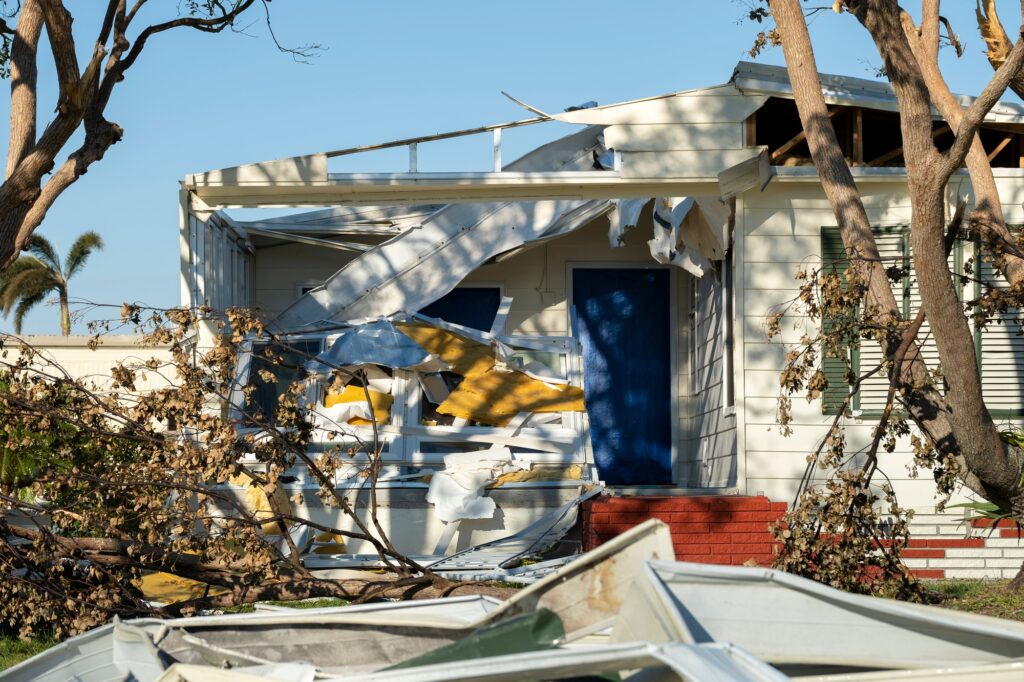Living in Florida means beautiful beaches, sunny days, and, unfortunately, hurricane season. Hurricanes can cause significant damage to homes, leaving many families overwhelmed. That’s why having the right hurricane coverage for homes is so important. It helps protect your property, your finances, and your peace of mind when storms roll in. Whether you’re a longtime Floridian or new to the state, understanding your coverage options is key to staying prepared.
Why Hurricane Coverage is Crucial for Florida Homeowners
Understanding Florida’s Hurricane Risk
Florida is no stranger to hurricanes. The state’s location between the Atlantic Ocean and the Gulf of Mexico makes it a prime target for these powerful storms. On average, about seven hurricanes form in the Atlantic each year, and Florida is directly hit by 40% of them. That’s more than any other state in the U.S.
Recent history proves how serious these storms can get. Hurricane Ian in 2022 caused over $100 billion in damages, ranking as one of the costliest U.S. storms. Hurricanes bring high winds, heavy rain, and storm surges, all of which can severely damage homes. If you live in Florida, preparing for hurricanes isn’t optional—it’s necessary.
The Financial Risks of Not Having Coverage
Hurricanes often leave behind a hefty price tag. The average cost to repair hurricane damage to a home is about $25,000. For major storms, those costs can skyrocket to six figures or more. Without hurricane coverage for homes, many families end up paying out of pocket, draining savings or taking on debt.
Standard homeowners insurance doesn’t always cover things like windstorm or flood damage—two major causes of destruction during hurricanes. Without the right coverage, you’re exposed to risks that could affect your financial stability for years. Hurricane insurance protects you from these costs, giving you a safety net when disaster strikes. ☂️
Having hurricane coverage for homes isn’t just smart. For many living in high-risk areas, it’s the barrier between recovery and ruin.
Types of Hurricane Coverage Available
Standard Homeowners Insurance
Most homeowners think their standard insurance covers everything. But that’s not always the case, especially for hurricane damage. Regular policies might cover things like fire or theft but could fall short for wind damage. For example, if a hurricane damages your roof and rain floods your living room, only the roof repairs might be covered. The water damage? Probably not.
Check your policy carefully. Many standard policies in Florida exclude windstorm and flood damage, which are two major issues during hurricanes. This is why additional hurricane coverage for homes is often necessary.
Windstorm Insurance
Windstorms are among the leading causes of property damage from hurricanes. Strong winds can peel off roofs, shatter windows, or completely level a house. That’s where windstorm insurance comes in. It covers structural damage caused by high winds, such as broken windows, missing shingles, or collapsed walls.
Florida law even requires insurers to offer windstorm policies in high-risk areas. According to the Insurance Information Institute, Florida is part of the “Wind Pool Zone,” where specialized windstorm policies are essential. Make sure your home has this coverage if it’s exposed to frequent storms.
Flood Insurance
Did you know that floods aren’t covered by standard homeowners insurance? This surprises many people. Hurricanes often bring heavy rain and storm surges, which can cause devastating floods. According to FEMA, just one inch of water in your home can cost over $25,000 in repairs.
If you live in a flood-prone area, flood insurance is a must. You can purchase it through the National Flood Insurance Program (NFIP). It covers the cost of repairing your home and replacing damaged belongings after a flood. Having this as part of your overall hurricane coverage for homes can save you from a financial nightmare.
Hurricane Deductibles
Hurricane deductibles are a unique part of insurance in states like Florida. Unlike standard deductibles, hurricane deductibles are calculated as a percentage of your home’s insured value. Typically, they range from 1% to 5%. For example, if your home is insured for $300,000 and your policy has a 2% hurricane deductible, you’d pay $6,000 out of pocket before insurance kicks in.
This might seem high, but it’s important to understand. These deductibles keep costs manageable for insurers, ensuring hurricane coverage for homes remains available. Always review your policy to know the exact amount you’d be responsible for in a hurricane claim.
Understanding these options is key to protecting your home and your finances during hurricane season. Take the time to review your policies and ensure you’re fully covered.
Factors to Consider When Choosing Hurricane Coverage
Assessing Your Home’s Risks
Not every home in Florida has the same level of risk. Start by understanding your property’s exposure to hurricanes:
- Location matters: Homes on the coast face higher wind and storm surge risks, while inland properties may be more prone to flooding from heavy rain.
- Flood zones: Check FEMA’s flood maps to see if your house is in a high-risk zone. About 40% of flood insurance claims come from areas not considered high risk.
- Construction quality: Homes built after 2002 often meet stricter building codes, reducing hurricane damage. Still, older homes may require upgrades, like hurricane shutters or reinforced roofing.
Consider these factors carefully. They help determine the type and extent of hurricane coverage for homes you’ll need.
Understanding Policy Limits
Every insurance policy has limits—the maximum amount it will pay if disaster strikes. Make sure your policy covers:
- Rebuilding costs: Don’t rely on your home’s market value. Focus on the cost to rebuild, which often includes higher material and labor prices after a major storm. The average cost to rebuild a 2,000-square-foot home in Florida is around $300,000.
- Personal property: Look at how much coverage is provided for belongings like furniture, appliances, or electronics. Policies usually offer payouts based on value before the storm, so keeping an updated inventory of your items helps.
- Special limits: Some policies cap coverage for valuables like jewelry or art. If this applies to you, you might need additional riders.
Understanding these limits ensures your hurricane coverage for homes provides enough protection without leaving you underinsured.
Comparing Deductibles
Hurricane deductibles work differently than standard deductibles. They’re based on percentages, as mentioned earlier. When choosing a policy:
- Balance cost vs. risk: Higher deductibles can lower your premiums, but they mean more out-of-pocket costs during a claim.
- Consider your savings: Choose a deductible amount you can realistically afford. Remember, Florida’s hurricane season runs from June to November, and some years bring multiple storms.
Making the right choice here ensures your hurricane coverage for homes is both affordable and dependable.
Additional Factors to Look Into
Lastly, dig deeper into your policy for these crucial points:
- Exclusions: Know what’s not covered. For example, many policies won’t cover storm-related mold or damage from neglected repairs.
- Claims process: Check how your provider handles claims. Fast, reliable response times can make a big difference after a storm.
- Bundling options: Some insurers offer discounts if you bundle hurricane coverage with other policies, like auto insurance.
Taking the time to compare policies and understand your needs ensures you have the best hurricane coverage for homes. It’s about being ready for whatever storm comes your way.
Tips for Filing Hurricane Insurance Claims
Document the Damage Immediately
The key to a smooth insurance claim is good documentation. After the storm passes:
- Take photos and videos: Snap clear images of all damage, including roofs, windows, furniture, and flooring. The more visuals you have, the better.
- Make a list: Write out a detailed inventory of damaged belongings and home areas. Include a description, estimated value, and receipts if you have them.
- Prevent further damage: Insurers expect you to minimize additional losses. Cover broken windows or roof holes with tarps, but don’t start permanent repairs until a claims adjuster inspects.
These steps ensure accurate processing for hurricane coverage for homes.
Contact Your Insurance Company Quickly
Don’t delay reaching out to your insurer. Most companies require you to report damages promptly. Here’s what to do:
- Call your insurance provider or use their app to file the claim.
- Provide your policy number, along with details of the damage.
- Be ready to answer questions, such as the timing of the damage and if emergency repairs have been done.
FEMA reported that delays in filing claims can sometimes result in denied payouts. Acting fast can help avoid this issue.
Understand the Claim Process
Every insurer handles hurricane claims slightly differently. Here’s what can help you understand the process:
- Adjuster visit: The insurance company will send an adjuster to inspect the damage. Be present when they arrive, so you can point out key issues.
- Estimate review: Ensure you and the adjuster agree on the damage and associated repair costs. If you feel their estimate is too low, you can negotiate or hire an independent adjuster.
- Payment timeline: Most policies aim to provide partial payments for immediate repairs quickly. Full reimbursement may come after a confirmed assessment.
Keeping organized throughout this process ensures you can fully benefit from your hurricane coverage for homes.
Common Mistakes to Avoid
Filing an insurance claim can feel overwhelming. Avoid these common errors:
- Not reading your policy: Know what’s covered and what isn’t. For instance, flood damage requires separate insurance.
- Throwing out damaged items: Unless instructed, keep damaged belongings until after the adjuster sees them.
- Skipping necessary forms: Check that all paperwork is complete. Missing one step can delay your payout.
Taking these precautions ensures the claim process is smoother and improves your chance of a full reimbursement for hurricane coverage for homes.
Follow Up If Necessary
If your claim stalls, follow up with your insurer. Persistence matters. If issues arise, contact Florida’s insurance regulator or hire an attorney specializing in insurance claims.
Remember, the goal is to get your home and life back to normal as soon as possible. Effective claims management is an essential part of hurricane coverage for homes. Protect your investment by staying proactive and informed.
Hurricane season can be unpredictable, but your preparation doesn’t have to be. Choosing the right hurricane coverage for homes starts with evaluating risks and understanding your policy options. Knowing how to file a claim, preparing your property, and budgeting for coverage are key steps to staying protected. Debunking common myths ensures you’re informed and ready for the storm.
Take action now to protect your home and finances. Contact us today for expert advice on finding the best hurricane coverage for homes. Your peace of mind is just a call away.







